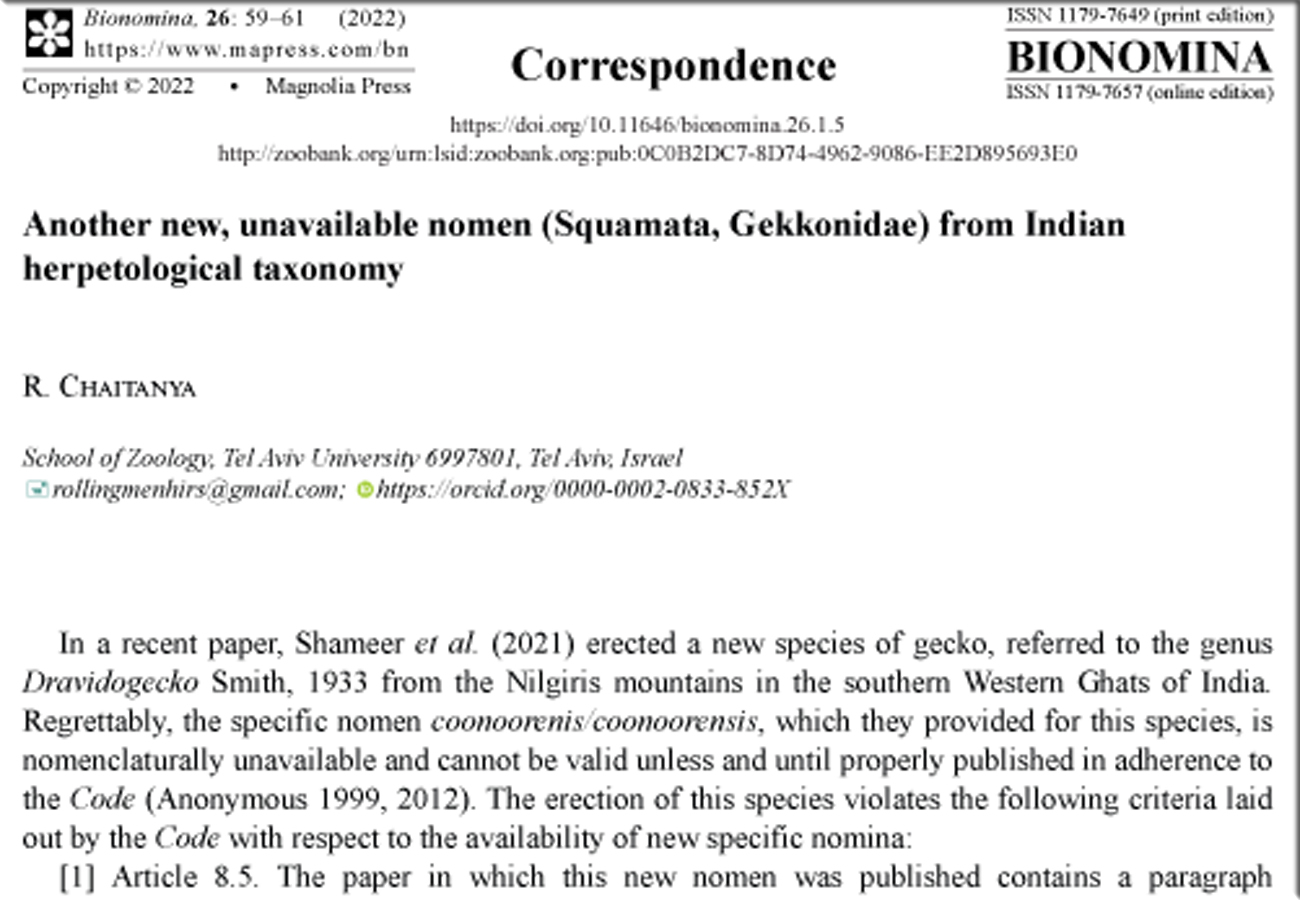Abstract
In a recent paper, Shameer et al. (2021) erected a new species of gecko, referred to the genus Dravidogecko Smith, 1933 from the Nilgiris mountains in the southern Western Ghats of India. Regrettably, the specific nomen coonoorenis/coonoorensis, which they provided for this species, is nomenclaturally unavailable and cannot be valid unless and until properly published in adherence to the Code (Anonymous 1999, 2012). The erection of this species violates the following criteria laid out by the Code with respect to the availability of new specific nomina:
References
Anonymous [International Commission on Zoological Nomenclature] (1999) International code of zoological nomenclature. ‘Fourth edition’. London (International Trust for zoological Nomenclature): i–xxix + 1–306.
Anonymous [International Commission on Zoological Nomenclature] (2012) Amendment of Articles 8, 9, 10, 21 and 78 of the International Code of Zoological Nomenclature to expand and refine methods of publication. Bulletin of zoological Nomenclature, 69 (3): 161–169. <https://doi.org/10.21805/bzn.v69i3.a8.161>.
Bauer, A. M., Parham, J. F., Brown, R. M., Stuart, B. L., Grismer, L., Papenfuss, T. J., Böhme, W., Savage, J. M., Carranza, S., Grismer, J. L., Wagner, P., Schmitz, A., Ananjeva, N. B. & Inger, R. F. (2010) Availability of new Bayesian-delimited gecko names and the importance of character-based species descriptions. Proceedings of the royal Society, (B), Biological Sciences, 278 (1705): 490‒492. <https://doi.org/10.1098/rspb.2010.1330>.
Dubois, A. (2017) Diagnoses in zoological taxonomy and nomenclature. Bionomina, 12: 63–85. <https://doi.org/10.11646/bionomina.12.1.8>.
Dubois, A., Crochet, P.-A., Dickinson, E. C., Nemésio, A., Aescht, E., Bauer, A. M., Blagoderov, V., Bour, R., de Carvalho, M. R., Desutter-Grandcolas, L., Frétey, T., Jäger, P., Koyamba, V., Lavilla, E. O., Löbl, I., Louchart, A., Malécot, V., Schatz, H. & Ohler, A. (2013) Nomenclatural and taxonomic problems related to the electronic publication of new nomina and nomenclatural acts in zoology, with brief comments on optical discs and on the situation in botany. Zootaxa, 3735 (1): 1–94. <https://doi.org/10.11646/zootaxa.3735.1.1>.
Dubois, A., Frétey, T. & Ineich, I. (2021) It is high time that taxonomists follow the Code. 3. The Bungarus romulusi case (Serpentes, Elapidae). Bionomina, 21: 120‒122. <https://doi.org/10.11646/bionomina.21.1.8>.
Dubois, A., Frétey, T. & Ohler, A. (2018) The Relictus case: it is high time that taxonomists follow the Code’s requirements for nomenclatural availability and validity of new zoological nomina. Bionomina, 13: 51–64. <https://doi.org/10.11646/bionomina.13.1.4>.
Frétey, T. & Dubois, A. (2021) It is high time that taxonomists follow the Code. 2. The Virgotyphlops case (Serpentes, Typhlopidae). Bionomina, 21: 117‒119. <https://doi.org/10.11646/bionomina.21.1.7>.
Shameer, T. T., Nittu, G., Mohan, G. Backer, J. S., Khedkar, G. B. & Sanil, R. (2021) Consequences of climate change in allopatric speciation and endemism: modeling the biogeography of Dravidogecko. Modelling Earth Systems and Environment: [1‒15]. [Published online without Zoobank registration]. <https://doi.org/10.1007/s40808-021-01284-4>.
Smith, M. A. (1933) Remarks on some Old World geckos. Records of the Indian Museum, 35 (1): 9‒19.


